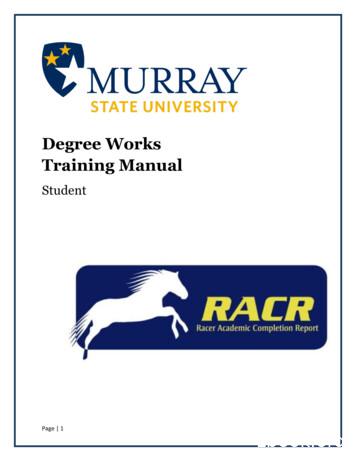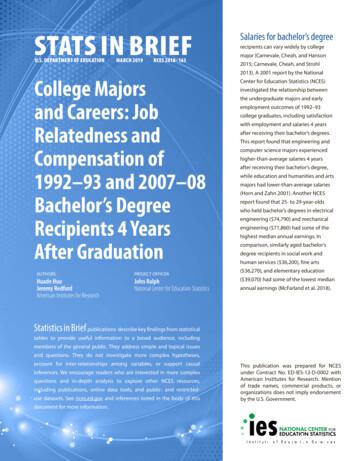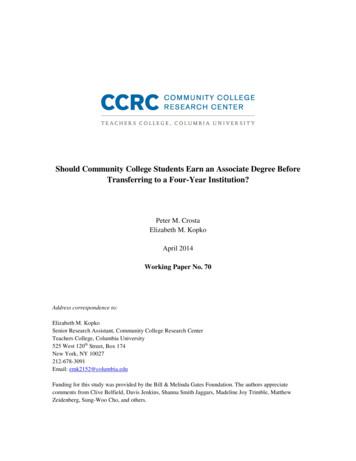M.Sc. Degree
M.Sc. DegreeINPhysicsSYLLABUSFORCREDIT BASED CURRICULUM(From the academic year 2014-15 onwards)DEPARTMENT OF PHYSICSNational Institute of Technology, Tiruchirappalli – 620015TAMILNADU, INDIA
M.Sc. (Physics)Department of PhysicsTHE INSTITUTEVisionTo provide valuable resources for industry and society through excellence in technicaleducation and research.Mission To offer state-of-the-art undergraduate, postgraduate and doctoral programmes. To generate new knowledge by engaging in cutting-edge research. To undertake collaborative projects with academia and industries. To develop human intellectual capability to its fullest potential.THE DEPARTMENTVision Provide a world class scientific platform for scientists and engineers.Mission Establish the department as a global player in Science and Technology. Excel in scientific R&D and consultancy. Create an environment for society aimed at knowledge enhancement.1
M.Sc. (Physics)Department of PhysicsCURRICULUMTotal minimum credits required for completing M.Sc. Programme in Physics is 66.SEMESTERCODEPH651PH653PH655PH657PH659COURSE OF STUDYMATHEMATICAL PHYSICS – ICLASSICAL MECHANICSQUANTUM MECHANICSELECTRONICSGENERAL PHYSICS LABORATORYELECTIVE – 1TOTAL 000P000C33330030300602317L3T0P0C8311IVCODECOURSE OF STUDYPH662 PROJECT WORK AND VIVA-VOCEELECTIVE – 4TOTAL CREDITS2T011000IIICOURSE OF STUDYSOLID STATE PHYSICSATOMIC AND MOLECULAR SPECTROSCOPYNUCLEAR AND PARTICLE PHYSICSNUMERICAL AND COMPUTATIONALMETHODSADVANCED PHYSICS LABORATORYELECTIVE – 3TOTAL CREDITSSEMESTERL333303IICOURSE OF STUDYMATHEMATICAL PHYSICS – IIELECTROMAGNETIC THEORYSTATISTICAL MECHANICSINSTRUMENTATIONELECTRONICS LABORATORYELECTIVE – 2TOTAL CREDITSSEMESTERCODEPH661PH663PH665PH667I
M.Sc. (Physics)LIST OF ELECTIVESDepartment of Physics*Odd SemesterPH611 DIGITAL SIGNAL AND IMAGE PROCESSINGPH613 BASICS OF ENGINEERING MATERIALSPH671 WAVEGUIDES AND MODERN OPTICSPH673 SOLAR PHOTOVOLTAIC TECHNOLOGYPH675 ADVANCED ELECTROMAGNETIC THEORYPH677 FIBER OPTIC SENSORSPH679 SENSORS AND TRANSDUCERSPH681 PHYSICS AND TECHNOLOGY OF THIN FILMSPH683 MAGNETISM AND SUPERCONDUCTING LEVITATIONPH685 MICRO-ELECTRO-MECHANICAL SYSTEMSEven SemesterPH610 ELECTRICAL, MAGNETIC AND OPTOELECTRONIC MATERIALSPH672 MICROPROCESSORSPH674 COMPUTER APPLICATIONS IN PHYSICSPH676 NON-DESTRUCTIVE TESTINGPH678 LASERS AND APPLICATIONSPH680 ADVANCED STATISTICAL METHODS AND PHASE TRANSITIONPH682 SEMICONDUCTOR PHYSICSPH684 NANOSCIENCE AND TECHNOLOGY & APPLICATIONS*Electives are not limited to the given list. Courses from other PG programmes can also bechosen as subjects of study. The courses will be offered based on convenience of thefaculty concerned.3
M.Sc. (Physics)Department of PhysicsI SEMESTERPH651 – MATHEMATICAL PHYSICS - IObjective: To introduce basic mathematical topics necessary to understand and appreciatevarious physical laws of nature.Unit – I: Vector AnalysisDefinition of vectors – scalar and vector product – triple products – gradient, divergence,curl – vector integration – Gauss’s theorem – Green’s theorem – Stoke’s theorem – Diracdelta function – Helmholtz theorem.Unit – II: Curved coordinates, TensorsOrthogonal coordinates – differential vector operators: gradient, divergence, curl – specialcoordinate systems: rectangular, spherical, cylindrical – tensors of rank two – contraction,direct product – quotient rule.Unit – III: Linear AlgebraDeterminants – matrices – inner product, direct product – orthogonal matrices – Eulerangles – symmetry properties – relation to tensors – Pauli matrices – eigenvalue equationand diagonalization – Cayley-Hamilton theorem – functions of matrices – hermitianmatrices.Unit – IV: Ordinary Differential EquationsFirst order equation – second order homogeneous equation – Wronskian – second solution– inhomogeneous equation – forced oscillation and resonance – power series method –Hermite and Legendre equations – Frobenius method – Bessel equation.Unit-V: ProbabilityDefinition – basic theorems – permutation and combination – method of counting –random variables – binomial and Poisson distributions – normal distribution – central limittheorem.Text Books1. G. B. Arfken and H.J. Weber, Mathematical Methods for Physicists, 5th edition,Academic Press (2001).2. E. Kreyszig, Advanced Engineering Mathematics, 8th edition, John Wiley & SonsInc. (1999).3. Mathematical Methods in the Physical Sciences, 3rd edition, Mary L. Boas, WileyIndia (2011).Reference Books1. L.A. Pipes and L.R. Harvill, Applied Mathematics for Engineers and Physicists,McGraw-Hill (1970).4
M.Sc. (Physics)Department of PhysicsOutcome: Students will be capable of handling variety of courses on mechanics andelectromagnetic theory.PH653 – CLASSICAL MECHANICSObjectives:1. To learn and use Newton’s laws of motion to solve advanced problems involvingthe dynamic motion of classical mechanical systems.2. To introduce differential calculus and other advanced mathematical techniquespertaining to the development of Lagrangian and Hamiltonian formulations ofclassical mechanics.3. To solve the dynamical problems using conservation laws.Unit – I: Lagrangian FormulationMechanics of a system of particles – constraints – Lagrangian equation of motion fromD'Alembert's and Hamilton's principles – conservation of linear momentum, energy andangular momentum – applications of the Lagrangian formalism.Unit – II: Central Force ProblemReduction to an one body problem – equation of motion and first integrals – onedimensional problems and classification of orbits – Kepler problem – scattering in a centralpotential – Rutherford formula – scattering cross section – transformation to laboratoryframes.Unit – III: Rigid Body and Oscillating SystemElements of rigid-body dynamics – Euler angles – symmetric top and applications – smalloscillations – normal mode analysis – normal modes of a linear tri-atomic molecule –forced oscillations – effect of dissipative forces on free and forced oscillations – dampeddriven pendulum.Unit – IV: Hamiltonian FormulationLegendre transformation – Hamiltonian equations of motion – cyclic coordinates – phasespace and Liouville's theorem – Poisson brackets.Unit – V: Special Theory of RelativityInternal frames – principle and postulate of relativity – Lorentz transformations – lengthcontraction, time dilation and the Doppler effect – velocity addition formula – four-vectornotation – energy-momentum – four-vector for a particle – relativistic invariance ofphysical laws.Text Books1. H. Goldstein, C. Poole and J. Safko, Classical Mechanics, 3nd edition, Addison &Wesley (2000).2. W. Greiner, Classical Mechanics, Springer-Verlag (2003).3. W. Greiner, Classical Mechanics – Point particles and Relativity, Springer (1989).5
M.Sc. (Physics)Department of PhysicsReference Books1. I.C. Percival and D. Richards, Introduction to Dynamics, Cambridge UniversityPress (1983).2. J.V. Jose and E.J. Saletan, Classical Dynamics: A Contemporary Approach,Cambridge University Press (1998).3. E.T. Whittaker, A Treatise on the Analytical Dynamics of Particles and RigidBodies, 4th edition, Cambridge University Press (1989).Outcome: Effective learning of items 1, 2 and 3 will enable the students to understand thecomplicated classical dynamical problems and find possible solutions for these problems.PH655 – QUANTUM MECHANICSObjectives:1. To introduce the mechanics of mater-waves necessary for uncovering the mysteriesof matter at atomic scale.2. To understand the spectrum of hydrogen.3. To introduce various approximate methods useful for more complex problems.Unit – I: Schrödinger EquationInadequacy of classical theory – de-Broglie hypothesis of matter waves – Heisenberg’suncertainty relation – Schrödinger’s wave equation – physical interpretation and conditionson wave function – eigenvalues and eigenfunctions – particle in a square-well potential –potential barrier – tunneling.Unit – II: Operators and EigenfunctionsLinear operator – orthogonal systems and Hilbert space – expansion in eigenfunctions –Hermitian operators – canonical commutation – commutations and uncertainty principle –state with minimum uncertainty.Unit – III: Solvable ProblemsHarmonic oscillator – operator method – Schrödinger equation for spherically symmetricpotentials – angular momentum operator – condition on solutions and eigenvalues –spherical harmonics – rigid rotor – radial equation of central potential – hydrogen atom –degenerate states.Unit – IV: Angular Momentum and SpinEigenvalues of angular momentum J – matrix representation of J – electron spin – Stern –Gerlach experiment – Zeeman effect – addition of angular momentum – Clebsh-Gordancoeffecients – identical particles with spin – Pauli exclusion principle.Unit – V: Approximation MethodsPerturbation theory for non-degenerate states – removal of degeneracy – Stark effect –variation method – WKB approximation – Bohr-Sommerfeld quantum condition –6
M.Sc. (Physics)Department of Physicspertubative solution for transition amplitude – selection rules – Fermi Golden rule –scattering of a particle by a potential.Text Books1. P.M. Mathews and K. Venkatesan, A Textbook of Quantum Mechanics, TataMcGraw-Hill (1976).2. J.L. Powell and B. Crasemann, Quantum Mechanics, Narosa Publishing House(1993).3. J.J. Sakurai, Modern Quantum Mechanics, Addison-Wesley (1999).4. Quantum Mechanics, Aruldhas, Prentice Hall of India (2006).Reference Books1. L.I. Schiff, Quantum Mechanics, McGraw-Hill (1968).2. D.J. Griffiths, Introduction to Quantum Mechanics, Pearson Education (2005).3. N. Zettili, Quantum Mechanics: Concepts and Applications, John Wiley (2009).4. L.D. Landau and E.M. Lifshitz, Quantum Mechanics (Non-relativistic Theory), 3rdedition, Elsevier (2011).Outcome: Intriguing probabilistic nature of matter at atomic scale will be understood.Students will be capable of handling courses like Statistical Mechanics, Solid StatePhysics, Spectroscopy and Nuclear Physics.PH 657 – ELECTRONICSObjective: To impart a diversified knowledge on circuit analysis, the semiconductordevices, FETs, operational amplifiers and digital circuits and their applications.Unit – I: Circuit Theorems and Special DiodesKirchoff’s laws for current and voltage – Thevenin’s and Norton’s theorems, superpositionand reciprocity theorems with examples – p-n junction diodes – Zener diode – tunneldiode – Schottky barrier diode – varactor diode-photodiode – solar cell – photodiodes andtransistors – light emitting diode – semiconductor laser – UJT – opto-couplers.Unit – II: Bipolar Transistor Amplifiers and FETsBiasing characteristics of junction transistors – analysis using re model-fixed bias-voltagedivider bias-emitter bias – direct coupled transistor amplifiers – single stage transistoramplifier – frequency response – feed back in amplifiers – effect of negative feedback inamplifiers – FETs – different types-low and high frequency FETs, frequency response ofFET – applicationsUnit-III: OscillatorsOscillator principle – oscillator types – frequency stability, RC oscillators – phase shiftoscillator – Wein bridge oscillator – LC tunable oscillators – limitations – multivibrators –monostable and astable – 555 IC timer – sine wave and triangular wave generation –crystal oscillators and their applications.7
M.Sc. (Physics)Department of PhysicsUnit – IV: Operational AmplifiersBasis of operational amplifier – characteristics – CMRR – inverting and non-invertingmodes- sum and difference amplifiers – integrating and differentiating circuits – feedbacktypes – current to voltage (ICVS) and voltage to current (VCIS) conversion –– op-ampapplication – instrumentation amplifiers – low pass and high pass active filters.Unit – V: Digital CircuitsLogic gates: De Morgan’s law, binary adder, comparators, decoders, multiplexers. Flipflops: RS flip-flop, JK flip- flop, JK master-slave flip-flops, T flip-flop, D flip-flop. Shiftregisters – synchronous and asynchronous counters – registers – A/D and D/A conversion.Text Books1. J. Milman and C.C. Halkias, Electronic Devices and Circuits, McGraw-Hill (1981).2. Albert Malvino, David J Bates, Electronics Principles, Tata McGraw-Hill (2007).3. R.J. Higgins, Electronics with Digital and Analogue Integrated Circuits, PrenticeHall (1983).Reference Books1. R. L. Boylsted and L. Nashelsky, Electronic Device and Circuits, PearsonEducation (2003).2. C.L Wadhwa, Network Analysis and Synthesis, New Age International Publishers,(2007).3. G.B. Calyton, Operation Amplifiers, ELBS (1980).Outcome: On successful completion of this course, students would be able i) tounderstand the construction, working function, characteristics and applications of varioussemiconductor devices and ii) to describe the design and applications of various digitalcircuits.PH659 – GENERAL PHYSICS LABORATORYObjective: To introduce the basic concepts of physics through hands on experience andimpart experimental skill to students.List of Experiments1. Hall Effect in Semiconductor2. Non-Destructive Testing – Ultrasonics3. Two Probe Method for Resistivity Measurement4. Wavelength Measurement of Laser using Diffraction Grating5. Numerical Aperture of an Optical Fiber6.Electron Spin Resonance8
M.Sc. (Physics)Department of Physics7. Specific Heat Capacity of Solids8.Half Shade Polarimeter and Strain Viewer9. Michelson Interferometer10. Acoustic Diffraction11. Vacuum Pumps – Low Pressure Measurement and Determination of Pumping Speed12. Zeeman effect13. Hydrogen Spectra and Rydberg Constant14. Forbe’s Method – Thermal Conductivity of Metal15. Kundt’s Tube16. Solar-Cell Characteristics17. Magnetic Susceptibility of Liquids – Quincke’s Method18. Curie Temperature of Magnetic Materials19. Dielectric Constant and Curie Temperature of Ferroelectric Ceramics20. Hysteresis (B – H Curve)21. Helmholtz Galvanometer22. Faraday Effect23. Millikan Oil Drop Experiment – e/m of Electron24. Determination of Planck’s Constant25. Cornu’s Method – Determination of Elastic Constants of Transparent MaterialsText Books1. General Physics Laboratory Manual, Department of Physics, NITT.Reference Books1. R.A. Dunlap, Experimental Physics: Modern Methods, Oxford University Press,New Delhi (1988).2. E.V. Smith, Manual for Experiments in Applied Physics, Butterworths (1970).3. D. Malacara (ed.), Methods of Experimental Physics, Series of Volumes, AcademicPress Inc. (1988).Outcome: The student will be able to understand the fundamental physics behind manyscientific discoveries through hands on experience.* * * * *9
M.Sc. (Physics)Department of PhysicsII SEMESTERPH652 – MATHEMATICAL PHYSICS - IIObjective: To introduce basic mathematical topics necessary to understand and appreciatevarious physical laws of nature.Unit – I: Infinite SeriesFundamental concepts – convergence test: Cauchy’s ratio test, Gauss’s test – alternatingseries – algebra of series – Taylor expansion – Binomial theorem – power series –asymptotic series – Stirling’s formula.Unit – II: Complex AnalysisFunctions of complex variable – derivative and Cauchy-Riemann equation – line integral –Cauchy's integral theorem – Cauchy’s integral formula – Laurent series – Cauchy's residuetheorem – poles – evaluation of residues – evaluation of definite integrals.Unit – III: Integral TransformsFourier series – convergence – functions of any period – complex form – Fourier integraltheorem – Fourier transform – Dirac delta function – Laplace transform – convolutiontheorem – transform of derivates – application to differential equation.Unit – IV: Group TheoryIntroduction to group theory – generators of continuous groups – rotation groups andangular momentum – SU(2)-SO(3) homomorphisms – orbital angular momentum –discrete groups – character table – irreducible representation.Unit – V: Partial Differential EquationsVibrating string – d’Alembert’s solution of wave equation – diffusion equation – solutionby Fourier series – Poisson equation – method of separation of variables – Green’sfunction method.Text Books1. G. B. Arfken and H.J. Weber, Mathematical Methods for Physicists, 5th edition,Academic Press (2001).2. E. Kreyszig, Advanced Engineering Mathematics, 8th edition, John Wiley & SonsInc. (1999).3. Mathematical Methods in the Physical Sciences, 3rd edition, Mary L. Boas, WileyIndia (2011).Reference Books1. L.A. Pipes and L.R. Harvill, Applied Mathematics for Engineers and Physicists,McGraw-Hill (1970).Outcome: Students will acquire enough mathematical skills to handle variety of equations,appear in various physical situations, with ease.10
M.Sc. (Physics)Department of PhysicsPH654 – ELECTROMAGNETIC THEORYObjective: To understand the nature of electric and magnetic force fields and the intricateconnection between them.Unit – I: ElectrostaticsElectric field – divergence and curl – electric potential – conductors – Laplace equation(1D, 2D and 3D) – uniqueness theorem – separation of variables: Cartesian and sphericalcoordinates – field of an electric dipole – polarization – Gauss’s law in dielectrics – lineardielectrics – energy density – boundary value problems.Unit – II: MagnetostaticsLorentz force – magnetic induction – electric current – equation of continuity – Biot-Savartlaw – magnetic potential – magnetization – Ampere’s law in magnetized material – energydensity – linear and nonlinear media.Unit – III: Maxwell’s EquationsFaraday’s law – generalization of Ampere’s law – Maxwell’s equations – boundaryconditions – scalar and vector potentials – gauge invariance – electromagnetic energy –Poynting’s theorem.Unit – IV: Electromagnetic WavesElectromagnetic wave equation (without source) – solution of 3D wave equation –propagation of EM waves in non-conducting media – waves in conducting media –polarization.Unit – V: Waves in Bounded RegionReflection and refraction at the boundary of non-conducting media – Fresnel’s coefficients– Brewster’s angle and critical angle – reflection from a conducting plane – wave guide –TE and TM waves – rectangular wave guide.Text Books1. D. J. Griffiths, Introduction to Electrodynamics, Prentice Hall of India, 3nd edition(1999).2. J.R. Reitz., F.J. Milford and R.W. Christy, Foundations of Electromagnetic Theory,4th edition, Pearson (2010).Reference Books1. J.D. Jackson, Classical Electrodynamics, Wiley-India, 3rd edition (2011).2. E.C. Jordon and K.G. Balmain, Electromagnetic Waves and Radiating Systems, 2ndedition, Prentice Hall of India (1998).3. W. Greiner, Classical Electrodynamics, 3rd edition, Springer (2010).4. L.D. Landau and E.M. Lifshitz, Electrodynamics of Continuous Media, 2nd edition,Elsevier (2008).11
M.Sc. (Physics)Department of PhysicsOutcome: Electromagnetic nature of radiation and its propagation in media will beunderstood.PH656 – STATISTICAL MECHANICSObjectives:1. To learn the connection between macroscopic and microscopic state of a system oflarge number of particles.2. To understand thermal equilibrium of a system in statistical sense.Unit – I: ThermodynamicsIdeal gas law – exact differentials – first law, internal energy, heat capacity – second law,Carnot’s cycle, Carnot’s theorem, absolute temperature – Clausius theorem, entropy –thermodynamic potentials, Maxwell’s relations – chemical potential – third law.Unit – II: Theory of EnsemblesPostulates: phase space, microstates, density of states, ensemble average – Liouville’stheorem – microcanonical ensemble – quantum phase space – canonical ensemble –partition function (N particle) – ideal gas law – grand canonical ensemble.Unit – III: Maxwell-Boltzmann StatisticsBoltzmann system (identical, distinguishable particles) – Maxwell-Boltzmann distribution– Lagrange’s multipliers – partition function (single particle) – thermodynamics of gases –equipartition theorem – paramagnetic susceptibility.Unit – IV: Bose-Einstein StatisticsPrinciple of indistinguishability – Bosons – Bose-Einstein distribution – Planck’s law ofradiation – Stefan’s law – Einstein model of phonons (semi-classical)
M.Sc. (Physics) Department of Physics 4 I SEMESTER PH651 – MATHEMATICAL PHYSICS - I Objective: To introduce basic mathematical topics necessary to understand and appreciate various physical laws of nature. Unit – I: Vector Analysis Definition of vectors – scalar and
What is Degree Works? Degree Works is an online advising tool to help monitor your progress toward degree completion. Degree Works matches Guam Community College's degree requirements to the coursework you have completed or have in progress in an easy-to-read worksheet that shows how those courses count toward degree requirements. Degree .
55 Rayalaseema College of Graduation Tirupati 56 RKM Degree College Penumuru 57 S.G. Govt. Degree College Piler 58 S.R. Govt. Degree College Punganur 59 S.V. Arts College (T.T.D.,) Tirupati 60 S.V. Oriental Degree College (T.T.D.,) Tirupati 61 SDHR Degree & PG College Tirupati 62 SEICOM Degree College Tirupati 63 SEICOM Degree College Bhakrapeta
DEGREEWORKS OVERVIEW What is Degree Works? Degree Works is a web-based degree audit tool designed to help you and your advisor monitor your progress toward receiving your degree. How does Degree Works work? Degree Works looks at the requirements for a program of study as well as the coursework you have completed to
GRADUATION 47 Baccalaureate Degree The Baccalaureate Degree in Educa-tion is the degree designed for students to enter the teaching profession. Requirements for the Baccalaureate Degree in Education The Baccalaureate Degree in Educa-tion will be awarded to students who meet the following requirements: 1. Recommendation of the faculty of
degree of a monomial is the sum of the powers of the variables that occur in the monomial. The degree of the zero monomial is undefined. For 2example, the monomial 3 xy z 5 has degree 8, because 1 2 5 8. The degree of a polynomial is the largest degree of any of the monomials in the polynomial. We assume that the polynomial is
degree attainment for Black adults, ages 25 to 64 in 41 states.2 We examine degree attainment for Latino adults in a companion brief. National Degree Attainment Trends Compared with 47.1 percent of White adults, just 30.8 percent of Black adults have earned some form of college degree (i.e., an associate degree or more).
degree completers in 1992-93 and 1.6 million in 2007-08. This brief is based on first-time bachelor's degree recipients only. 2 2 Because estimates are for first-time bachelor's degree recipients only, the 11.3 percent of 1992-93 bachelor's degree recipients and 7.0 percent of 2007-08 bachelor's degree recipients who had earned
start at two-year colleges earn a bachelor's degree within six years (Shapiro et al., 2012). Although the expected pathway for community college students seeking a bachelor's degree includes earning an associate degree, little is known about the value of the associate degree or its impact on bachelor's degree completion.























